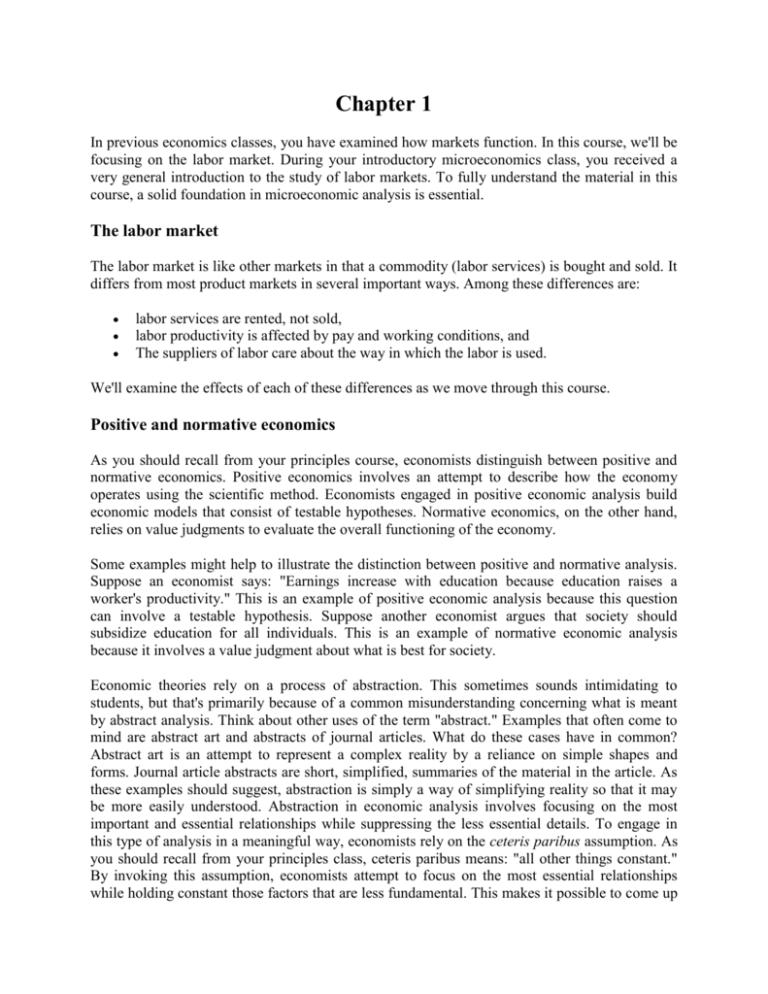File - BSC Economics
advertisement

Chapter 1 In previous economics classes, you have examined how markets function. In this course, we'll be focusing on the labor market. During your introductory microeconomics class, you received a very general introduction to the study of labor markets. To fully understand the material in this course, a solid foundation in microeconomic analysis is essential. The labor market The labor market is like other markets in that a commodity (labor services) is bought and sold. It differs from most product markets in several important ways. Among these differences are: labor services are rented, not sold, labor productivity is affected by pay and working conditions, and The suppliers of labor care about the way in which the labor is used. We'll examine the effects of each of these differences as we move through this course. Positive and normative economics As you should recall from your principles course, economists distinguish between positive and normative economics. Positive economics involves an attempt to describe how the economy operates using the scientific method. Economists engaged in positive economic analysis build economic models that consist of testable hypotheses. Normative economics, on the other hand, relies on value judgments to evaluate the overall functioning of the economy. Some examples might help to illustrate the distinction between positive and normative analysis. Suppose an economist says: "Earnings increase with education because education raises a worker's productivity." This is an example of positive economic analysis because this question can involve a testable hypothesis. Suppose another economist argues that society should subsidize education for all individuals. This is an example of normative economic analysis because it involves a value judgment about what is best for society. Economic theories rely on a process of abstraction. This sometimes sounds intimidating to students, but that's primarily because of a common misunderstanding concerning what is meant by abstract analysis. Think about other uses of the term "abstract." Examples that often come to mind are abstract art and abstracts of journal articles. What do these cases have in common? Abstract art is an attempt to represent a complex reality by a reliance on simple shapes and forms. Journal article abstracts are short, simplified, summaries of the material in the article. As these examples should suggest, abstraction is simply a way of simplifying reality so that it may be more easily understood. Abstraction in economic analysis involves focusing on the most important and essential relationships while suppressing the less essential details. To engage in this type of analysis in a meaningful way, economists rely on the ceteris paribus assumption. As you should recall from your principles class, ceteris paribus means: "all other things constant." By invoking this assumption, economists attempt to focus on the most essential relationships while holding constant those factors that are less fundamental. This makes it possible to come up with relatively simply theories (called economic models) that rely on a small number of hypotheses. The validity of an economic model is generally evaluated by how well it can explain and predict behavior. Economists tend to focus on testing the predictions of a model, rather than on examining the assumptions of a model. Presumably, though, a model's predictive ability will be affected by whether or not the assumptions are consistent with individual behavior. Economists rely on statistical analysis (called econometric analysis) to evaluate the predictive success of their models. Fundamental concepts of positive economics One of the most basic concepts of positive economic analysis is the concept of scarcity. As you should recall from your principles course, economists assume that resources are scarce relative to society's wants and needs. (You may recall the standard definition of economics that states that economics is the study of how limited resources are used to satisfy unlimited wants.) The fundamental economic problem facing every individual and every society is how to deal with the problem of scarcity. A fundamental hypothesis of positive economic analysis is that individuals deal with the problem of scarcity by making choices based upon rational self-interest. By this, economists simply mean that individuals make choices that provide the highest expected level of satisfaction given the information and constraints facing the individual at the time a choice is made. In your principles course, this concept was discussed in the framework of utility maximization, where utility is a measure of the level of individual happiness or satisfaction. For individuals who operate businesses, utility maximization results in profit-maximizing behavior (under a wide variety of conditions). Normative analysis As your text notes, the only normative concept on which virtually all economists agree is that a Pareto improvement is a desirable change. As you may recall from your principles class, a Pareto improvement is a change that benefits one or more individuals and harms no one. A desirable outcome occurs once one reaches a state of Pareto efficiency (also commonly called Pareto optimality), a situation in which no further Pareto improvements can be made. Once a state of Pareto efficiency is achieved, any change that benefits one or more people will result in harm to someone else. Since it is not possible to determine whether the harm to one person outweighs the benefits to others (since interpersonal comparisons of utility are not possible), it is not possible to evaluate whether any change in such a state increases or decreases social welfare when an economy has achieved a state of Pareto efficiency. One criticism of relying solely on the criterion of Pareto efficiency is that it tends to support the status quo, since it is often difficult to find practical examples of changes in a society that do not harm at least one person. Still, if an economic system is to be devised, it is preferable that it result in outcomes that are Pareto efficient. Markets and Pareto efficiency Under ideal conditions a market economy will result in Pareto efficient outcomes. If there is perfect information and all of the benefits and costs from trade are captured by the individuals involved in transactions, voluntary trades will result in Pareto improvements. If there are no barriers to such transactions, these trades will take place until no further Pareto improvements are possible. This is expected to occur in both output and resource markets (such as the labor market). Market failure In practice, however, market failure does occur do to a variety of factors. In particular, market failure may result from: imperfect information, transaction barriers, price distortions, the nonexistence of markets when externalities are present, public goods, and Capital market imperfections. Let's review each of these possibilities. Imperfect information Voluntary trade between individuals will result in Pareto improvements as long as each individual can find out about the possibility of such a trade and knows what they will be getting from the trade. In many markets, however, imperfect information exists so that some individuals will not know that such trades are available or do have incorrect expectations of the characteristics of the product they are acquiring. In the case of the labor market, workers may not always know all of the risks and characteristics of jobs that they accept. They also do not have perfect information about all of the potential employment opportunities that may be available. On the other side of the market, firms do not have perfect information concerning the ability, motivation, collegiality, and other characteristics of potential workers. Because of this imperfect information, some employment choices will result in decisions that are not Pareto improvements. Government often steps in to correct for this type of market failure by issuing regulations or providing information. State employment agencies that provide listings of job opportunities are another example of an attempt to correct for imperfect information. Transaction barriers Laws prohibiting transactions prevent markets from achieving potential improvements. Laws specifying minimum wages, mandated overtime premiums, regulating working conditions, prohibiting child employment, etc. all prevent transactions that would have provided mutual benefit to the employer and employee if the prohibited transactions had been realized. Similar transaction barriers prevent Pareto improvements in occupations that are prohibited by law. Transaction costs (such as transportation costs) or financial barriers may also result in some transactions not being realized. Price distortions Price distortions occur when the price of a good does not reflect the social cost of the good. Taxes, tariffs, subsidies, and similar types of intervention may cause a price to diverge from the marginal cost of producing the good. (As noted below, taxes and subsidies may be appropriate corrections for market failure when externalities are present.) If a tax results in an artificially high price of a commodity, too little of the commodity will be consumed. A subsidy, on the other hand, that result in an artificially low price will result in overconsumption of the commodity. Nonexistence of markets when externalities are present As you should recall from your principles class, externalities are side effects of production or consumption that provide either benefits or costs to those not directly involved in the transaction. When negative externalities are present, overproduction takes place since the market price understates the social cost of producing the good. Underproduction occurs when positive externalities are present since the benefit to society is greater than the benefit received by individual consumers. If property rights are established, negotiations among all of the affected parties may result in Pareto improvements (this is the Coase theorem discussed in your microeconomics principles course). Your textbook uses the example of smokers and nonsmokers in an office negotiating over whether smoking should be allowed in the workplace as an example of such a situation. In practice, however, markets will generally fail to take external costs and benefits into account (as Coase himself noted in his classic paper). In this case, government may correct for negative externalities by taxing or regulating the activity; a correction for positive externalities involves subsidies or regulations. Public goods Public goods are goods that are non rival in consumption. Once the good is produced, it is available for everyone's consumption; one person's consumption does not reduce either the quantity or quality of the product available to anyone else. As you should recall from your principles class, public goods tend to be under produced because of the free-rider problem. Negotiations over working conditions is an example of a public good in the workplace. If a safer work environment is created, it benefits all workers, not just the worker who negotiated the improvement. The problem, of course, is that everyone has an incentive to let someone else complain to management about unsafe working conditions. In such a situation, such negotiations will often not take place. One of the reasons for the existence of unions is that they provide a mechanism for negotiation over public goods in the workplace. Government also often attempts to correct for the presence of public goods in labor markets. Capital market imperfections The capital market is the market for investment in both physical and human capital. In the absence of government subsidized and guaranteed student loan programs, however, is that private lenders had little incentive to provide funds for human capital investments. Loans for the acquisition of physical capital can be secured by the use of collateral. No such collateral is available for investments in human capital. This is, of course, the main reason for the existence of government subsidized and guaranteed student loans. Equity vs. Efficiency Throughout this course, we'll examine many situations in which policymakers are faced with a tradeoff between equity and efficiency. Attempts to make market outcomes more equitable often results in the loss of economic efficiency. Unemployment compensation programs provide a more equitable distribution of income, but reduce the incentive for unemployed workers to get back to work. Disability programs and welfare programs often have similar equity and efficiency implications.









